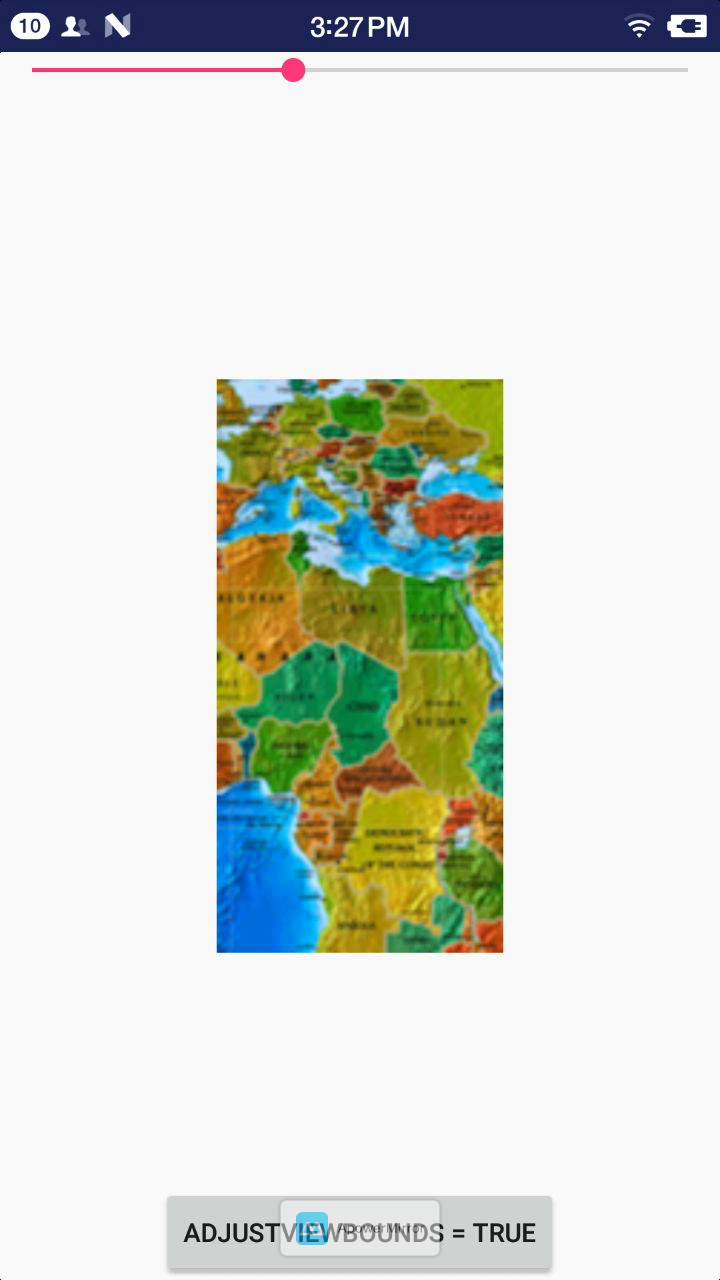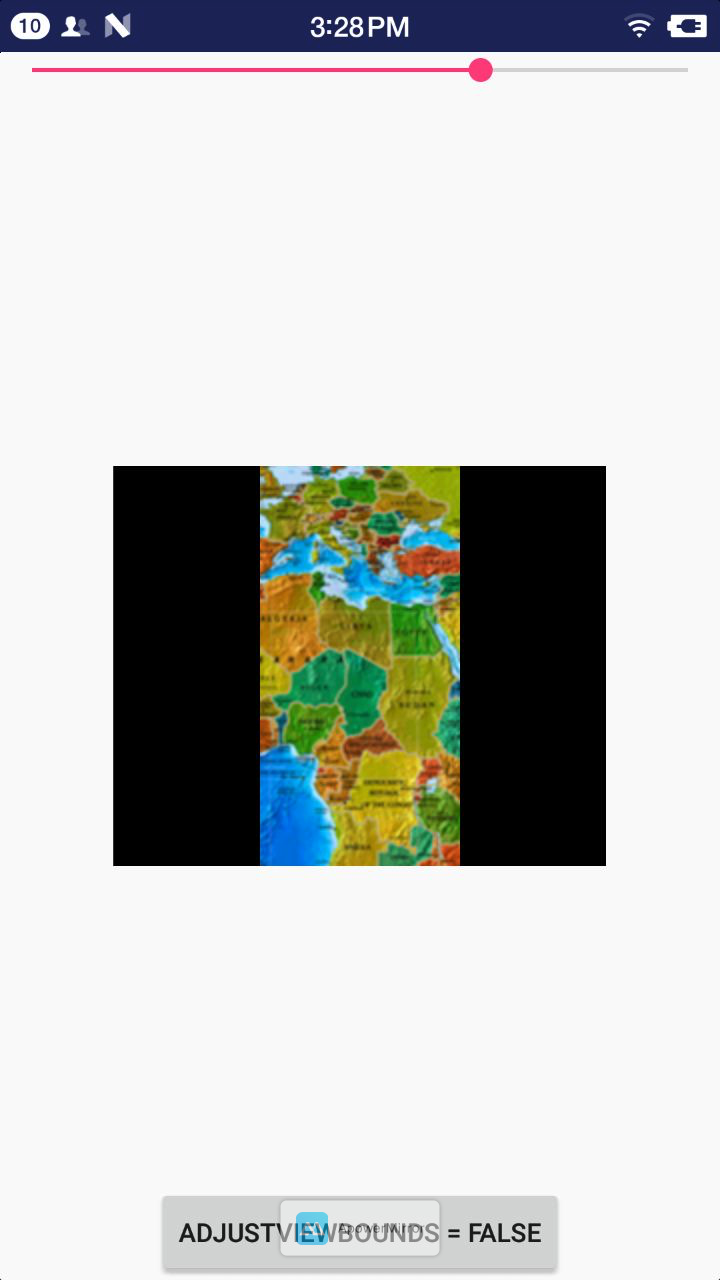一、整体介绍
ImageView的ScaleType都有很多介绍了,android:adjustViewBounds="true" 设置这个属性,在源码里可以看到。
@android.view.RemotableViewMethod
public void setAdjustViewBounds(boolean adjustViewBounds) {
mAdjustViewBounds = adjustViewBounds;
if (adjustViewBounds) {
setScaleType(ScaleType.FIT_CENTER);
}
}这里很直观setScaleType(ScaleType.FIT_CENTER);其他ScaleType就不用考虑了,默认就是它了。
这个属性适应情景:当宽高有且仅有一个设置为wrapContent的时候是有用的。
作用:根据drawable的宽高比例,调制ImageView的设置为WrapContent的那个宽或者高。
二、demo测试
1、ImageView设置高为wrapContent,宽为固定值
2、Seek bar动态调节宽度为确定值
2、button切换android:adjustViewBounds的属性
代码如下
布局
<?xml version="1.0" encoding="utf-8"?>
<FrameLayout xmlns:android="http://schemas.android.com/apk/res/android"
android:layout_width="match_parent"
android:layout_height="match_parent"
android:orientation="vertical">
<ImageView
android:id="@+id/image"
android:layout_width="200dp"
android:layout_height="wrap_content"
android:layout_gravity="center"
android:adjustViewBounds="true"
android:background="@android:color/black"
android:scaleType="fitCenter"
android:src="@drawable/map" />
<SeekBar
android:id="@+id/seeKBar"
android:layout_width="match_parent"
android:layout_height="wrap_content"
android:layout_gravity="top|center_horizontal" />
<Button
android:id="@+id/switch_adjustBounds"
android:layout_width="wrap_content"
android:layout_height="wrap_content"
android:layout_gravity="bottom|center_horizontal" />
</FrameLayout>代码
package qin.xue.imageviewscaletype;
import android.app.Activity;
import android.os.Bundle;
import android.support.annotation.Nullable;
import android.view.View;
import android.view.ViewGroup;
import android.widget.Button;
import android.widget.ImageView;
import android.widget.SeekBar;
/**
* Created by qinxue on 2018/4/26.
*/
public class MainActivity extends Activity implements View.OnClickListener, SeekBar.OnSeekBarChangeListener {
Button button;
ImageView imageView;
SeekBar seekBar;
@Override
protected void onCreate(@Nullable Bundle savedInstanceState) {
super.onCreate(savedInstanceState);
setContentView(R.layout.activity_main_layout);
imageView = findViewById(R.id.image);
button = findViewById(R.id.switch_adjustBounds);
seekBar = findViewById(R.id.seeKBar);
seekBar.setOnSeekBarChangeListener(this);
seekBar.setMax(getResources().getDisplayMetrics().widthPixels);
seekBar.setProgress(imageView.getWidth());
button.setOnClickListener(this);
setButtonText(imageView.getAdjustViewBounds());
}
@Override
public void onClick(View v) {
switch (v.getId()) {
case R.id.switch_adjustBounds:
switchAdjustBuounds();
break;
}
}
private void switchAdjustBuounds() {
imageView.setAdjustViewBounds(!imageView.getAdjustViewBounds());
setButtonText(imageView.getAdjustViewBounds());
}
private void setButtonText(boolean isAdjust) {
button.setText("AdjustViewBounds = " + imageView.getAdjustViewBounds());
}
@Override
public void onProgressChanged(SeekBar seekBar, int progress, boolean fromUser) {
ViewGroup.LayoutParams params = imageView.getLayoutParams();
params.width = progress;
imageView.setLayoutParams(params);
}
@Override
public void onStartTrackingTouch(SeekBar seekBar) {
}
@Override
public void onStopTrackingTouch(SeekBar seekBar) {
}
}三、测试
当android:adjustViewBounds="true" 时,图片高度会根据宽度的变化自适应,如图

当当android:adjustViewBounds="false" 时高度不会自适应,表现为fitCenter,高度保持为Drawable的高度不变,如图。

demo地址:https://github.com/xueqin123/AdjustViewBounds





 本文深入探讨了Android中ImageView的自适应属性android:adjustViewBounds,通过示例代码和实际操作展示了该属性如何使图片按比例缩放以适应不同尺寸的布局。
本文深入探讨了Android中ImageView的自适应属性android:adjustViewBounds,通过示例代码和实际操作展示了该属性如何使图片按比例缩放以适应不同尺寸的布局。
















 610
610

 被折叠的 条评论
为什么被折叠?
被折叠的 条评论
为什么被折叠?








